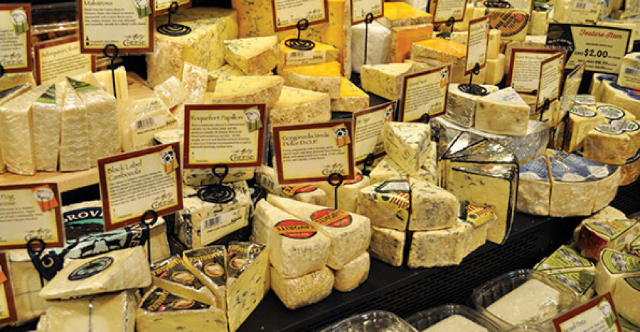Fermented foods have recently become darlings of the foodie and healthy eating sets. But they’re also faves of food scientists and nutritionists. Their history is long, broadly based, and intriguing. And the benefits touted for fermented foods are hard to ignore.
 Cheese: Probably the most common fermented food in the Western
Cheese: Probably the most common fermented food in the Western
World. After Bread, Beer, Wine and Spirits, of course…
What are they?
I’ll bet you can’t name the most common fermented foods we have in the supermarket these days. Because we don’t think of them as ‘fermented’. Sure. You’ll nail Wine and Beer. Vinegar follows those naturally. Yogurt is an obvious one.
But Health.com provides a much broader, more inclusive definition: “Fermented foods include those that are either made with or contain live, active bacteria. Research suggests that regularly including fermented foods in your diet can help diversify the healthy bacteria in your gut. ”
They’ve been popular for thousands of years, in one form or another. And their current resurgence in popularity is just the latest.
What are their benefits?
First and foremost, fermented foods have been proven to help you maintain a healthy gut microbiome. It can also affect your overall mental and emotional state, and degrade your sleep quality. That means, they influence all the functions of your digestive system. When the microbes are happy, your whole body is happy. If they’re not happy, they can make life miserable.
One major issues with a bad gut microbiome is metabolic syndrome. The Johns Hopkins website defines it thus: “Metabolic syndrome refers to the presence of a cluster of risk factors specific for cardiovascular disease. Metabolic syndrome greatly raises the risk of developing diabetes, heart disease, stroke, or all three.”
Conditions that can arise, or be aggravated by metabolic syndrome include: obesity, low HDL (‘good’) cholesterol, high triglycerides, high blood pressure, and high blood sugar.
What are some you didn’t know?
Bread
Yes! All yeast breads are products of fermentation. Yeast bacteria ferment sugars in flour ro produce carbon dioxide gas. The gas bubbles throughout the dough expand when heated (during proofing/rising, and then baking) and make the bread light and fluffy. Alcohol is also produced by yeast fermentation. But it is driven off by the heat of baking.
Distilled spirits
Whiskey, some Vodkas, and Sake are examples of distilled spirits made from grains. Other Vodkas, Rum and Brandy are made from such diverse feed stocks as (respectively) as potato starch, sugar cane and distilled wine. You can ferment almost any kind of starch, turning its starches to sugars, and the sugars to alcohol. Finally, the alcohol is separated from some or all of the water (and concentrated) by evaporation via the distillation process.
Sauerkraut
This, of course, is simply fermented cabbage. It’s shredded cabbage rubbed with salt and left to ferment. The cabbage releases its own water which combines with the salt to form brine. Different Saurkraut recipes call for fermentation periods of from 3 to 10 days. It’s Germany’s national dish!
Kimchi
Some in the West refer to this, the national food of Korea, as Asian Sauerkraut. But it’s much more than that, offering all the benefits of Sauerkraut and more. And many Koreans it at at every meal. Kimchi, too, is fermented cabbage, but the salt is accompanied by strong spices and chilis, making it a potent condiment. It’s considered by some to be a legitimate side dish.
Cheese
Milk is fermented by a ‘culture’ of bacteria that separate the milk solids from the water. The solids are then gathered and pressed into wooden forms that produce the traditional round, cylindrical or rectangular cheeses. Different kinds of milk (cow, sheep, goat, even yak), treated with different ‘cultures’, can produce thousands of different types of cheese.
Miso
The Asian culinary staple is used as the flavour base of myriad soups and sauces. It’s essentially fermented soy bean paste. It comes in various flavour strengths. Generally, the darker briown the Miso, the stronger the flavour. There’s also a ‘red’ Miso that has a flavour all its own. Miso is considered a natural source of concentrated umami ‘punch’. And, as with most fermented foods, it contains a lot of salt.
Sourdough
Zoe.com relates: “Sourdough bread is thought to have originated in ancient Egypt. The sourdough starter is made by fermenting a mixture of flour, water, and salt. A portion of this starter is then mixed with more flour and water to leaven the bread dough.” The ‘starter’ replaces yeast in sourdoughs. You can keep a starter going for years if you save a little back from each bread recipe and add mroe flour, water and salt. The bacteria will multiply, over a few days to a week, into enough new starter to leaven the next batch of bread. And so on..
My take
There are other foods, from other cultures that may be unfamiliar, or seem strange to you. Some, like Kefir (a fermented milk product from Russia) may not appeal to the Western palate. But you can get most of the same benefits from drinking thin yogurt.
If you don’t regularly consume some of the above fermented foods, do yourself a favour and start now. Healthline.com says “While there are currently no official guidelines regarding how often you should eat fermented foods, adding a few servings to your daily diet may be beneficial”
So get to it, and give your gut microbiome a treat!
~ Maggie J.

